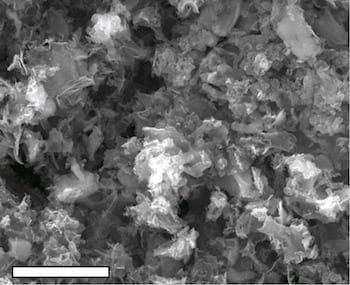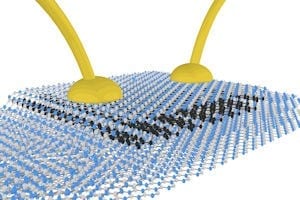
Rice University scientists find possible replacement for platinum as catalyst
Rice University chemists who developed a unique form of graphene have found a way to embed metallic nanoparticles that turn the material into a useful catalyst for fuel cells and other applications.
Laser-induced graphene, created by the Rice lab of chemist James Tour last year, is a flexible film with a surface of porous graphene made by exposing a common plastic known as polyimide to a commercial laser-scribing beam. The researchers have now found a way to enhance the product with reactive metals.
The research appears this month in the American Chemical Society journal ACS Nano.
With the discovery, the material that the researchers call “metal oxide-laser induced graphene” (MO-LIG) becomes a new candidate to replace expensive metals like platinum in catalytic fuel-cell applications in which oxygen and hydrogen are converted to water and electricity.
“The wonderful thing about this process is that we can use commercial polymers, with simple inexpensive metal salts added,” Tour said. “We then subject them to the commercial laser scriber, which generates metal nanoparticles embedded in graphene. So much of the chemistry is done by the laser, which generates graphene in the open air at room temperature.
“These composites, which have less than 1 percent metal, respond as ‘super catalysts’ for fuel-cell applications. Other methods to do this take far more steps and require expensive metals and expensive carbon precursors.”
Initially, the researchers made laser-induced graphene with commercially available polyimide sheets. Later, they infused liquid polyimide with boron to produce laser-induced graphene with a greatly increased capacity to store an electrical charge, which made it an effective supercapacitor.
Read more: Laser-burned graphene gains metallic powers
The Latest on: Metal oxide-laser induced graphene
[google_news title=”” keyword=”metal oxide-laser induced graphene” num_posts=”10″ blurb_length=”0″ show_thumb=”left”]
via Google News
The Latest on: Metal oxide-laser induced graphene
- Laser-Induced Graphene Sensors for Wearable Gait Recognitionon April 15, 2024 at 6:27 pm
In a recent paper published in Microsystems & Nanoengineering, researchers integrated a pressure sensor array based on laser-induced graphene (LIG) and multiple sensor units into wearable gait ...
- Metal Oxide Nanoparticles: Versatile Materials for Diverse Applicationson April 10, 2024 at 9:19 am
Examples include mechanical milling, laser ablation, and lithography. These methods are often simple and scalable but may have limitations in terms of size control and uniformity. Metal oxide ...
- Graphene articles from across Nature Portfolioon November 13, 2021 at 6:38 am
Graphene is a two-dimensional material consisting of a single layer of carbon atoms arranged in a honeycomb structure. Its properties include high strength and good conductivity of heat and ...
- 2. Key Images Inserted in the Thesis (IMAGE)on September 7, 2021 at 12:18 am
highly swollen graphene electrodes based on ultrashort-pulse laser, (c) schematic illustration of manufacturing process of sticker-type flexible MSC using highly swollen laser-induced-graphene ...
- Graphene Oxide In Pfizer Covid-19 Vaccines? Here Are The Latest Unsupported Claimson July 10, 2021 at 1:54 pm
One example of such a claim was an Instagram post that stated: “99% Graphene Oxide in Pfizer V4X? Spanish scientists obtain vial of Pfizer v4xin3 and find that 98-99%.” In this case ...
- Graphene sieve turns seawater into drinking wateron December 18, 2018 at 9:30 am
New research shows graphene can filter common salts from water to make it safe to drink Findings could lead to affordable desalination technology Graphene-oxide membranes have attracted considerable ...
- Metal Oxide Varistors (MOVs) Informationon February 8, 2018 at 2:32 pm
These clamping devices contain a matrix of zinc oxide grains sandwiched between two metal plates which serve as electrodes. The boundaries between grains form diode junctions which allow current to ...
- Graphene tunes in to new frequencyon January 15, 2016 at 2:26 am
Graphene helps open up new technology possibilities by controlling terahertz frequencies. Research could lead to safer X-rays and faster internet speeds. The fascinating electrical properties of ...
- Laser Etching Graphene Supercapacitorson October 2, 2015 at 6:57 pm
By placing a thin film on top of a DVD (or any plastic CD shaped disc), and coating it with graphite oxide, you can literally print patterns of graphene using the laser in your DVD burner.
via Bing News











